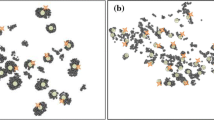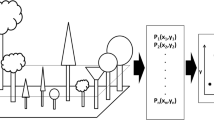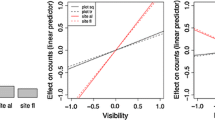Abstract
Ecologists commonly use matrix models to study the population dynamics of plants. Most studies of plant demography use plot-based methods to collect data, in part, because mapped individuals are easier to relocate in subsequent surveys and survey methods can be standardized among sites. However, there is tremendous variation among studies, both in terms of plot arrangement and the total area sampled. In addition, there has been little discussion of how alternative sampling arrangements influence estimates of population growth rates (λ) calculated with matrix models. We surveyed the literature to determine what sampling designs are most used in studies of plant demography using matrix models. We then used simulations of three common sampling techniques—using a single randomly placed plot, multiple randomly placed plots, and systematically distributed plots—to evaluate how these alternative strategies influenced the precision of estimates of λ. These simulations were based on long-term demographic data collected on 13 populations of the Amazonian understory herb Heliconia acuminate (Heliconiaceae). We found that the method used to collect data did not affect the bias or precision of estimates in our system—a surprising result, since the advantage in efficiency that is gained from systematic sampling is a well-known result from sampling theory. Because the statistical advantage of systematic sampling is most evident when there is spatial structure in demographic vital rates, we attribute this result to the lack of spatially structured vital rates in our focal populations. Given the likelihood of spatial autocorrelation in most ecological systems, we advocate sampling with a systematic grid of plots in each study site, as well as that researchers ensure that enough area is sampled—both within and across sites—to encompass the range of spatial variation in plant survival, growth, and reproduction.



Similar content being viewed by others
References
Bates D, Maechles M (2007) lme4: linear mixed-effects models using S4 classes. R package. http://CRAN.R-project.org/package=lme4
Batista WB, Platt WJ, Macchiavelli RE (1998) Demography of a shade-tolerant tree (Fagus grandifolia) in a hurricane-disturbed forest. Ecology 79:38–53
Bellhouse DR (1977) Some optimal designs for sampling in two dimensions. Biometrika 64:605–611
Berry F, Kress WJ (1991) Heliconia: an identification guide. Smithsonian Institution Press, Washington, DC, USA
Bhatti AU (2004) Using geostatistics to find optimum plot size for field research experiments. Commun Soil Sci Plant Anal 35:2299–2310
Bierregaard RO, Gascon C, Lovejoy TE, Mesquita R (eds) (2002) Lessons from Amazonia: the ecology and conservation of a fragmented forest. Yale University Press, New Haven
Bierzychudek P (1999) Looking backwards: assessing the projections of a transition matrix model. Ecol Appl 9:1278–1287
Boyce MS, Haridas CV, Lee CT, Demography NS (2006) Demography in an increasingly variable world. Trends Ecol Evol 21:141–148
Bruna EM (2003) Are plants in rain forest fragments recruitment limited? Tests with an Amazonian herb. Ecology 84:932–947
Bruna EM, Kress WJ (2002) Habitat fragmentation and the demographic structure of an Amazonian understory herb (Heliconia acuminata). Conserv Biol 16:1256–1266
Caswell H (2001) Matrix population models: construction, analysis, and interpretation. Sinauer Associates, Sunderland
Chung MY, Nason JD, Chung MG (2005) Spatial genetic structure in populations of the terrestrial orchid Orchis cyclochila (Orchidaceae). Plant Syst Evol 254:209–219
Cochran WG (1946) Relative accuracy of systematic and stratified random samples for a certain class of populations. Annals of Mathematical Statistics 17:164–177
Condit R (1998) Tropical forest census plots. Springer-Verlag, Berlin
Crawley MJ (1990) The population dynamics of plants. Phil Trans R Soc Lond B 330:125–140
de Kroon H, van Groenendael J, Ehrlen J (2000) Elasticities: a review of methods and model limitations. Ecology 81:607–618
Delesalle VA, Blum S (1994) Variation in germination and survival among families of Sagittaria latifolia in response to salinity and temperature. Int J Plant Sci 155:187–195
Doak DF, Gross K, Morris WF (2005) Understanding and predicting the effects of sparse data on demographic analyses. Ecology 86:1154–1163
Escudero A, Romao RL, de la Cruz M, Maestre FT (2005) Spatial pattern and neighbour effects on Helianthemum squamatum seedlings in a Mediterranean gypsum community. J Veg Sci 16:383–390
Fagroud M, Van Meirvenne M (2002) Accounting for soil spatial autocorrelation in the design of experimental trials. Soil Sci Soc Am J 66:1134–1142
Fiske IJ, Bruna EM, Bolker BM (2008) Effects of sample size on estimates of population growth rates calculated with matrix models. PLoS ONE 3:e3080
Gotelli NJ (1991) Demographic models for Leptogorgia virgulata, a shallow-water gorgonian. Ecology 72:457–467
Gray A (2003) Monitoring stand structure in mature coastal Douglas-fir forests: effect of plot size. For Ecol Manag 175:1–16
Gross K (2002) Efficient data collection for estimating growth rates of structured populations. Ecology 83:1762–1767
Horvitz CC, Schemske DW (1995) Spatiotemporal variation in demographic transitions of a tropical understory herb: projection matrix analysis. Ecol Monogr 65:155–192
Hynynen J, Ojansuu R (2003) Impact of plot size on individual-tree competition measures for growth and yield simulators. Can J For Res (Revue Canadienne De Recherche Forestiere) 33:455–465
Jalonen J, Vanha-Majamaa I, Tonteri T (1998) Optimal sample and plot size for inventory of field and ground layer vegetation in a mature Myrtillus-type boreal spruce forest. Ann Bot Fennici 35:191–196
Kenkel NC, Podani J (1991) Plot size and estimation efficiency in plant community studies. J Veg Sci 2:539–544
Kunin WE (1993) Sex and the single mustard: population density and pollinator behavior effects on seed set. Ecology 74:2145–2160
Laurance WF, Ferreira LV, Rankin-De Merona JM, Hutchings RW (1998) Influence of plot shape on estimates of tree diversity and community composition in central Amazonia. Biotropica 30:662–665
Lefkovitch LP (1965) The study of population growth in organisms grouped by stages. Biometrics 21:1–18
Legendre P (1993) Spatial autocorrelation: trouble or new paradigm? Ecology 74:1659–1673
Legendre P, Legendre L (1998) Numerical ecology. Elsevier, New York
Leslie PH (1945) On the use of matrices in certain population mathematics. Biometrika 33:183–212
Moloney KA (1988) Fine-scale spatial and temporal variation in the demography of a perennial bunchgrass. Ecology 69:1588–1598
Morris WF, Doak DF (2002) Quantitative conservation biology: theory and practice of population viability analysis. Sinauer Associates, Sunderland
Münzbergová Z, Ehrlén J (2005) How best to collect demographic data for population viability analysis models. J Appl Ecol 42:1115–1120
Parker IM (2000) Invasion dynamics of Cytisus scoparius: a matrix model approach. Ecol Appl 10:726–743
Pebesma EJ, Bivand RS (2005) Classes and methods for spatial data in R. R News 5:9–13
Picard N, Nouvellet Y, Sylla ML (2004) Relationship between plot size and the variance of the density estimator in West African savannas. Can J For Res (Revue Canadienne De Recherche Forestiere) 34:2018–2026
Poultney R, Riley J, Webster R (1997) Optimizing plot size and shape for field experiments on terraces. Exp Agric 33:51–64
R Development Core Team (2007) R: a language and environment for statistical computing. R Foundation for Statistical Computing, Vienna, Austria
Schnurr JL, Canham CD, Ostfeld RS, Inouye RS (2004) Neighborhood analyses of small-mammal dynamics: Impacts on seed predation and seedling establishment. Ecology 85:741–755
Silva Matos DM, Freckelton RP, Watkinson AR (1999) The role of density dependence in the population dynamics of a tropical. Ecology 80:2635–2650
Silvertown J, Franco M, Pisanty I, Mendoza A (1993) Comparative plant demography: relative importance of life-cycle components to the finite rate of increase in woody and herbaceous perennials. J Ecol 81:465–476
Thompson SK (2002) Sampling. Wiley, New York
Valverde T, Silvertown J (1998) Variation in the demography of a woodland understorey herb (Primula vulgaria) along the forest regeneration cycle: Projection matrix analysis. J Ecol 86:545–562
Wisdom MJ, Mills LS, Doak DF (2000) Life stage simulation analysis: estimating vital-rate effects on population growth for conservation. Ecology 81:628–641
Yates F (1948) Systematic sampling. Phil Trans R Soc Lond Ser A 241:345–377
Acknowledgments
We thank M. Oli, B. Bolker, and three anonymous reviewers for helpful discussions and comments on the manuscript. We would also like to thank the many technicians and students who helped conduct the censuses and the logistical support of the BDFFP and its staff. Financial support was provided by the US National Science Foundation (award numbers DEB-0614149 and DEB-0614339) and the University of Florida. This is publication number 547 in the BDFFP Technical Series. Code used to conduct simulations is available from IJF upon request.
Author information
Authors and Affiliations
Corresponding author
Appendix: studies of plant demography using matrix models reviewed to determine the sample sizes used to parameterize models
Appendix: studies of plant demography using matrix models reviewed to determine the sample sizes used to parameterize models
-
Allphin L and Harper KT (1997) Demography and life history characteristics of the rare Kachina daisy (Erigeron kachinensis, Asteraceae). American Midland Naturalist 138:109–120.
-
Alvarez-Buylla ER (1994) Density dependence and patch dynamics in tropical rain forests: matrix models and applications to a tree species. American Naturalist 143:155–191.
-
Barot S, Gignoux J, Vuattoux R et al. (2000) Demography of a savanna palm tree in Ivory Coast (Lamto): population persistence and life-history. Journal of Tropical Ecology 16:637–655.
-
Batista WB, Platt WJ and Macchiavelli RE (1998) Demography of a shade-tolerant tree (Fagus grandifolia) in a hurricane-disturbed forest. Ecology 79:38–53.
-
Berg H (2002) Population dynamics in Oxalis acetosella: the significance of sexual reproduction in a clonal, cleistogamous forest herb. Ecography 25:233–243.
-
Bierzychudek P (1982) The demography of Jack-in-the-Pulpit, a forest perennial that changes sex. Ecological Monographs 52:335–351.
-
Brewer JS (2001) A demographic analysis of fire-stimulated seedling establishment of Sarracenia alata (Sarraceniaceae). American Journal of Botany 88:1250–1257.
-
Bruna EM (2003) Are plant populations in fragmented habitats recruitment limited? Tests with an Amazonian herb. Ecology 84: 932-947.
-
Brys R, Jacquemyn H, Endels P et al. (2004) The effects of grassland management on plant performance and demography in the perennial herb Primula veris. Journal of Applied Ecology 41:1080–1091.
-
Bullock SH (1980) Demography of an undergrowth palm in littoral Cameroon. Biotropica 12:247–255.
-
Byers DL and Meagher TR (1997) A comparison of demographic characteristics in a rare and a common species of Eupatorium. Ecological Applications 7:519–530.
-
Calvo RN (1993) Evolutionary demography of orchids: intensity and frequency of pollination and the cost of fruiting. Ecology 74:1033–1042.
-
Charron D and Gagnon D (1991) The demography of northern populations of Panax quinquefolium (American Ginseng). Journal of Ecology 79:431–445.
-
Cipollini ML, Wallacesenft DA and Whigham DF (1994) A model of patch dynamics, seed dispersal, and sex-ratio in the dioecious shrub Lindera benzoin (Lauraceae). Journal of Ecology 82:621–633.
-
Cipollini ML, Whigham DF and O’Neill J (1993) Population growth, structure, and seed dispersal in the understory herb Cynoglossum virginianum: a population and patch dynamics model. Plant Species Biology 8:117–129.
-
Ehrlen J (1995) Demography of the perennial herb Lathyrus vernus: II. Herbivory and population dynamics. Journal of Ecology 83:297–308.
-
Endress BA, Gorchov DL and Noble RB (2004) Non-timber forest product extraction: effects of harvest and browsing on an understory palm. Ecological Applications 14:1139–1153.
-
Enright N and Ogden J (1979) Applications of transition matrix models in forest dynamics: Araucaria in Papua New Guinea and Nothofagus in New Zealand. Australian Journal of Ecology 4:3–24.
-
Enright NJ and Watson AD (1992) Population dynamics of the Nikau Palm Rhopalostylis sapida (Wendl. et. Drude) in a temperate forest remnant near Auckland, New Zealand. New Zealand Journal of Botany 30:29–43.
-
Eriksson O (1988) Ramet behavior and population growth in the clonal herb Potentilla anserina. Journal of Ecology 76:522–536.
-
Fiedler PL (1987) Life history and population dynamics of rare and common Mariposa Lilies (Calochortus pursh: Liliaceae). Journal of Ecology 75:977–996.
-
Forbis TA and Doak DE (2004) Seedling establishment and life history trade-offs in alpine plants. American Journal of Botany 91:1147–1153.
-
Garcia MB (2003) Demographic viability of a relict population of the critically endangered plant Borderea chouardii. Conservation Biology 17:1672–1680.
-
Guardia R, Raventos J and Caswell H (2000) Spatial growth and population dynamics of a perennial tussock grass (Achnatherum calamagrostis) in a badland area. Journal of Ecology 88:950–963.
-
Guedje NM, Lejoly J, Nkongmeneck BA et al. (2003) Population dynamics of Garcinia lucida (Clusiaceae) in Cameroonian Atlantic forests. Forest Ecology and Management 177:231–241.
-
Hara M, Kanno H, Hirabuki Y et al. (2004) Population dynamics of four understorey shrub species in beech forest. Journal of Vegetation Science 15:475–484.
-
Hoffmann WA (1999) Fire and population dynamics of woody plants in a neotropical savanna: matrix model projections. Ecology 80:1354–1369.
-
Horvitz CC and Schemske DW (1995) Spatiotemporal variation in demographic transitions of a tropical understory herb: projection matrix analysis. Ecological Monographs 65:155–192.
-
Huenneke LF and Marks PL (1987) Stem dynamics of the shrub Alnus incana ssp. Rugosa: transition matrix models. Ecology 68:1234–1242.
-
Kiviniemi K (2002) Population dynamics of Agrimonia eupatoria and Geum rivale, two perennial grassland species. Plant Ecology 159:153–169.
-
Lefebvre C and Chandler-Mortimer A (1984) Demographic characteristics of the perennial herb Armeria maritima on zinc lead mine wastes. Journal of Applied Ecology 21:255–264.
-
Lesica P (1995) Demography of Astragalus scaphoides and effects of herbivory on population growth. Great Basin Naturalist 55:142–150.
-
Matos JF, Trevisan MC, Estrada CA et al. (2000) Comparative demography of two giant caulescent rosettes (Espeletia timotensis and E. spicata) from the high tropical Andes. Global Ecology and Biogeography 9:403–413.
-
McCauley RA and Ungar IA (2002) Demographic analysis of a disjunct population of Froelichia floridana in the mid-Ohio River Valley. Restoration Ecology 10:348–361.
-
Meagher TR (1982) The population biology of Chamaelirium luteum, a dioecious member of the lily family 2. Sex population projections and stable population structure. Ecology 63:1701–1711.
-
Menges ES and Quintana-Ascencio PF (2004) Population viability with fire in Eryngium cuneifolium: Deciphering a decade of demographic data. Ecological Monographs 74:79–99.
-
Moloney KA (1988) Fine-scale spatial and temporal variation in the demography of a perennial bunchgrass. Ecology 69:1588–1598.
-
Morris WF and Doak DF (2005) How general are the determinants of the stochastic population growth rate across nearby sites? Ecological Monographs 75:119–137.
-
Nakashizuka T (1991) Population dynamics of coniferous and broad-leaved trees in a Japanese temperate mixed forest. Journal of Vegetation Science 2:413–418.
-
Nordbakken JF, Rydgren K and Okland RH (2004) Demography and population dynamics of Drosera anglica and D. rotundifolia. Journal of Ecology 92:110–121.
-
Olmsted I and Alvarez-Buylla ER (1995) Sustainable harvesting of tropical trees: demography and matrix models of two palm species in Mexico. Ecological Applications 5:484–500.
-
Oostermeijer JGB, Brugman ML, deboer ER et al. (1996) Temporal and spatial variation in the demography of Gentiana pneumonanthe, a rare perennial herb. Journal of Ecology 84:153–166.
-
Parker IM (2000) Invasion dynamics of Cytisus scoparius: a matrix model approach. Ecological Applications 10:726–743.
-
Pico FX and Riba M (2002) Regional-scale demography of Ramonda myconi: remnant population dynamics in a preglacial relict species. Plant Ecology 161:1–13.
-
Pinard M (1993) Impacts of stem harvesting on populations of Iriartea deltoidea (Palmae) in an extractive reserve in Acre, Brazil. Biotropica 25:2–14.
-
Pinero D, Martinezramos M and Sarukhan J (1984) A Population model of Astrocaryum mexicanum and a sensitivity analysis of its finite rate of increase. Journal of Ecology 72:977–991.
-
Platt WJ, Evans GW and Rathbun SL (1988) The population dynamics of a long-lived conifer (Pinus palustris). American Naturalist 131:491–525.
-
Rae JG and Ebert TA (2002) Demography of the endangered fragrant prickly apple cactus, Harrisia fragrans. International Journal of Plant Sciences 163:631–640.
-
Silva Matos DMS, Freckleton RP and Watkinson AR (1999) The role of density dependence in the population dynamics of a tropical palm. Ecology 80:2635–2650.
-
Stokes KE, Allchin AE, Bullock JM et al. (2004) Population responses of Ulex shrubs to fire in a lowland heath community. Journal of Vegetation Science 15:505–514.
-
Svensson BM, Carlsson BA, Karlsson PS et al. (1993) Comparative long-term demography of 3 species of Pinguicula. Journal of Ecology 81:635–645.
-
Tolvanen A, Schroderus J and Henry GHR (2001a) Age- and stage-based bud demography of Salix arctica under contrasting muskox grazing pressure in the High Arctic. Evolutionary Ecology 15:443–462.
-
Tolvanen A, Schroderus J and Henry GHR (2001b) Demography of three dominant sedges under contrasting grazing regimes in the High Arctic. Journal of Vegetation Science 12:659–670.
-
Valverde T and Silvertown J (1998) Variation in the demography of a woodland understorey herb (Primula vulgaris) along the forest regeneration cycle: projection matrix analysis. Journal of Ecology 86:545–562.
-
Vavrek MC, mcgraw JB and Yang HS (1997) Within-population variation in demography of Taraxacum officinale: season- and size-dependent survival, growth and reproduction. Journal of Ecology 85:277–287.
Rights and permissions
About this article
Cite this article
Fiske, I.J., Bruna, E.M. Alternative spatial sampling in studies of plant demography: consequences for estimates of population growth rate. Plant Ecol 207, 213–225 (2010). https://doi.org/10.1007/s11258-009-9666-4
Received:
Accepted:
Published:
Issue Date:
DOI: https://doi.org/10.1007/s11258-009-9666-4




